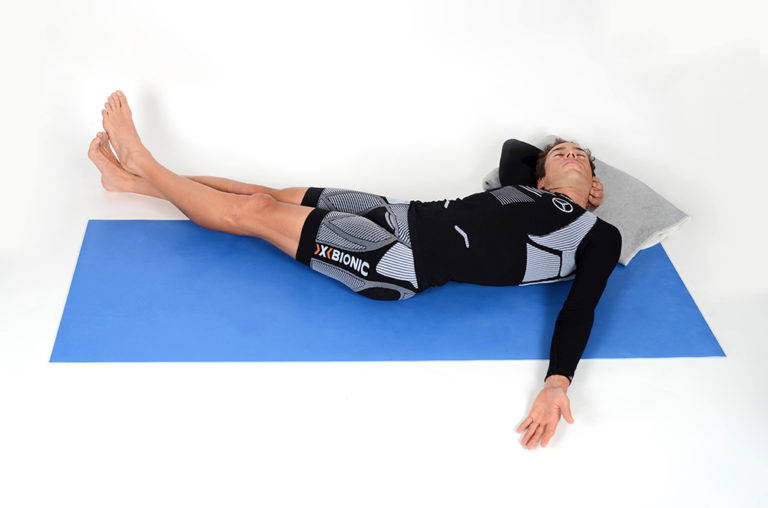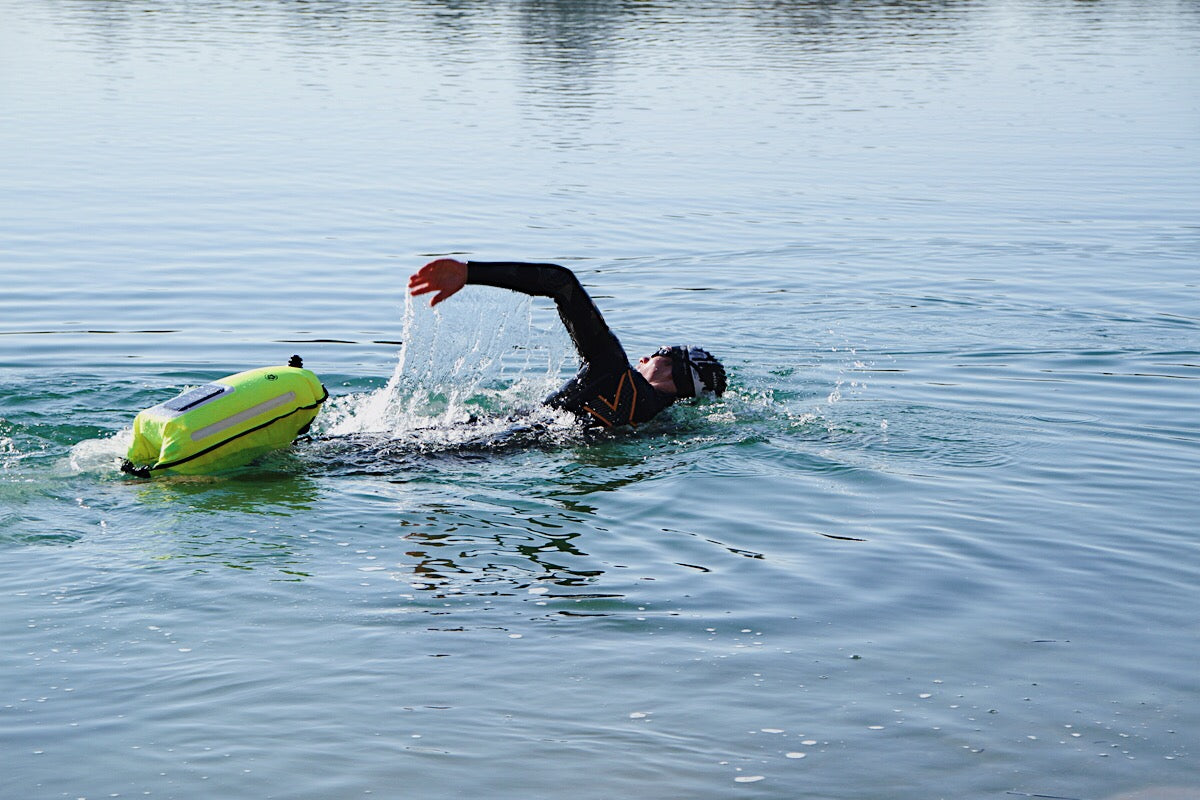In order to develop an optimal ability to regenerate, various effective exercises can be practiced in yoga. Important aspects here are various relaxation techniques such as muscle relaxation or deep relaxation. In addition, long, intense stretches and observing your own breathing are essential aspects of regenerative exercises. Even pure breathing technique, which is very extensive in yoga, can be enough to relax. Nevertheless, a shortened chest musculature prevents an optimal breathing movement.
Useful from a therapeutic point of view: Tonus regulation. Since one cannot say exactly which part of the autonomic nervous system is more active, one tries to stimulate both sympathetic and parasympathetic areas.
areas of the parasympathetic nervous system
Laryngeal mobilization (the vagus nerve, as the largest parasympathetic representative, has a narrow anatomical course to the larynx. Oscillations on the os sacrum (sacrum). If breathing harmonizes or the athlete unconsciously forced exhalation, this is a sign of a parasympathetic balance .
areas of the sympathetic nervous system
To stimulate nerve plexuses (so-called plexuses) in the upper abdomen through oscillations. In the area of the thoracic spine. Technique for this would be the so-called "rib raising". Sympathetic areas are often very sensitive to pain. If the sensitivity to pain decreases, this is a sign of vegetative balance.
In a regenerative yoga class, the exercises are usually performed without a long warm-up. The athlete tries to hold the position with little muscular effort for between three and five minutes. By staying in the postures for a long time, the body is encouraged to release internal tension and to stretch deeper into the deeper layers of connective tissue (fascia). In this form of fascia yoga, you consciously breathe into the stretched body parts. Gently and consciously you step further into the stretch through the exhalation. More and more studies show that, in addition to the muscles, it is primarily the connective tissue that reacts to stress and tension and can even cause pain.
Pigeon/Kapotasana
Directions::
- Starting position: all fours
- Your hands are under your shoulders, your knees are hip-width apart
- Bring one knee forward and place it on the floor slightly behind your wrist. Your shin forms a diagonal. Your heel points towards your body
- Center your pelvis
- Your other leg is stretched straight back without pulling it outward. Your knee and the top of your foot are on the floor
- Support yourself firmly on the floor with spread fingertips and keep your upper body straight. Your gaze is directed forward, your neck and shoulders are relaxed, you pull your navel in towards your spine
- Tighten your pelvic floor
- As you exhale, slowly lean down by moving your fingers forward. Tighten your pelvic floor to support your back and keep your hips stable.
You should pay attention to this:
- Weight distribution: Your weight is evenly distributed on both legs
- Extremely shortened hip flexor: Initially, keep the foot of the bent leg close to the hip or even place it under your buttocks so that your lower leg is parallel to the straight leg. If the bend forward stretch is too intense for you, place a pillow, your hands, or your forearms under your forehead. You can also keep your elbows and hands in a higher position to slowly train your flexibility
- Neck: Keep neck and neck long and relaxed
- Waiver: If you have knee injuries or problems, you should not practice the yoga pigeon at first
Attached are two lying exercises that support flank breathing. Flank breathing is just a flow of breath that is directed into the flanks so that the costal arches expand.
Crocodile / Nakarasana - Twisting pose in the supine position
Directions:
- Lie straight on your back
- Arms are stretched out horizontally from your shoulders
- Keep your legs in the air at right angles and from this position carefully place both knees on the floor in one direction
- Thighs are at a 90° angle to the calf
- Knees are approximately at navel height
- Breathe deeply and calmly into the abdomen. When exhaling, the head is turned to one direction, the posture shifts in the opposite direction.
- Shoulders and arms continue to touch the floor
- Posture reinforcement can be obtained by using the opposite hand of the leg to push the knee further toward the floor as long as none of the shoulder blades are lifting off the floor
You should pay attention to this:
- Shoulders: Both shoulders should always be in contact with the floor
- Spine: Try to keep your spine straight by pulling your buttocks to the right or left before you lower your knees to the floor at right angles.
Banana/flank stretch
Directions::
- To gently stretch the triceps, flanks and abductors, lie flat on your back.
- Buttocks remain fixed to the floor.
- Put your head in the crook of your elbow.
- Your torso moves in one direction with your head as much as possible.
- Keep your pelvis parallel and your buttocks on the floor.
- Pull the leg on the bent side of the trunk in the same direction as long as your buttocks do not lose their grip on the ground. When you have reached the end position, place the other leg over this leg and slightly interlock your feet
- Breathe deeply and consciously into the stretched flank.
- Close your eyes and stay in this pose for several minutes
- then lie back in the middle and straight on the mat and feel.
- Now switch sides.
You should pay attention to this:
- Buttocks: The buttocks should always remain in contact with the floor
- End the exercise carefully: When you exit the exercise, first detach your foot from the other and put your legs back to the middle of the mat. Then, move your torso back to the center of the mat in the same way, and then carefully release your head from your arm.
- Trace: Close your eyes again and trace
Stretch your hips and buttocks while lying down
Directions:
- Start in the supine position
- Legs are bent hip-width apart
- Place a heel on the raised leg in front of the knee
- Grasp the hollows of your knees on the raised leg with your hands
- Then lift your raised leg off the floor until you feel a stretch in your buttocks
- Your pelvis remains on the pad
- You can intensify the stretch by alternatively holding your hands in front of your knees instead of behind your knees. You can also use your elbow to gently press your outwardly rotated leg even further away from you
You should pay attention to this:
- Neck: The neck should remain relaxed, the shoulders resting lightly on the floor. If there is a lack of mobility here, blankets can be placed under the head to relieve the neck area.
- Hip: This exercise is performed from the hips, your knee should not feel any pressure
Final relaxation/corpse pose (Savasana)
The final relaxation pose sounds like the most obvious, simple, and beautiful pose in yoga. Unfortunately, this pose is the one with the greatest challenge. Similar to meditation, it can push us to the limits of our consciousness. Many tend to fall asleep in this position. This requires great concentration. This attitude is often ignored. But it is precisely in this posture that the body has the time to process the tension of the yoga class, to reduce stress hormones and to recharge your batteries.
Directions:
- Lie flat on your back.
- Place your feet hip-width apart and let them naturally slide outwards
- The pelvis is relaxed
- You should place your arms at a 30-45° angle next to your upper body. Make sure your shoulders are not hunched. Palms face up to open chest and shoulders
- Check that the spine is long
- Breathe in slowly and deeply. With each exhalation, you lower your body deeper into the floor and relax all your muscles
- Remain in this resting position while trying not to think about anything. If thoughts do come up, try to go back and observe your breath
- Mentally go through your body from bottom to top and relax. Start with your feet, legs, buttocks, abdomen, back, shoulders, arms, hands, neck, head and crown. Also relax your facial muscles. You can also walk through the body in more detail: Ex: jaw, lips, tongue, nose, cheeks, forehead and scalp.
- You should hold this pose for at least 5 minutes, but no longer than 20 minutes. Find a suitable duration for you
- To get out of this relaxation pose, stretch or make yourself very small and rounded. Bend your legs, lie on your right side in fetal position. Then sit down with your eyes closed and consciously breathe in and out deeply again. Again, as you inhale, raise your arms overhead and bring your hands into prayer position in front of your chest. Give yourself a smile and bow to yourself by saying Namaste. Namasté means: I greet the divine in you! Namasté comes from Sanskrit, "nam" for "to bow" and is a sign of the highest respect that one should also have for oneself
You should pay attention to this:
- Cervical spine: Depending on the shape of your head, it can be uncomfortable to lie on the mat. Do you feel the same? Then try putting a soft yoga blanket under your head.
- Lower Back: Does your tailbone feel hard, or is Savasana uncomfortable for you? Then try a yoga pad under your knees.
- Carousel of thoughts: If you try to suppress them frantically, it often has the opposite effect. Concentrating on the breath, for example, is better.
THE BIG NEOPRENE TEST TOUR 2023
+++ Starts on February 10th +++




















